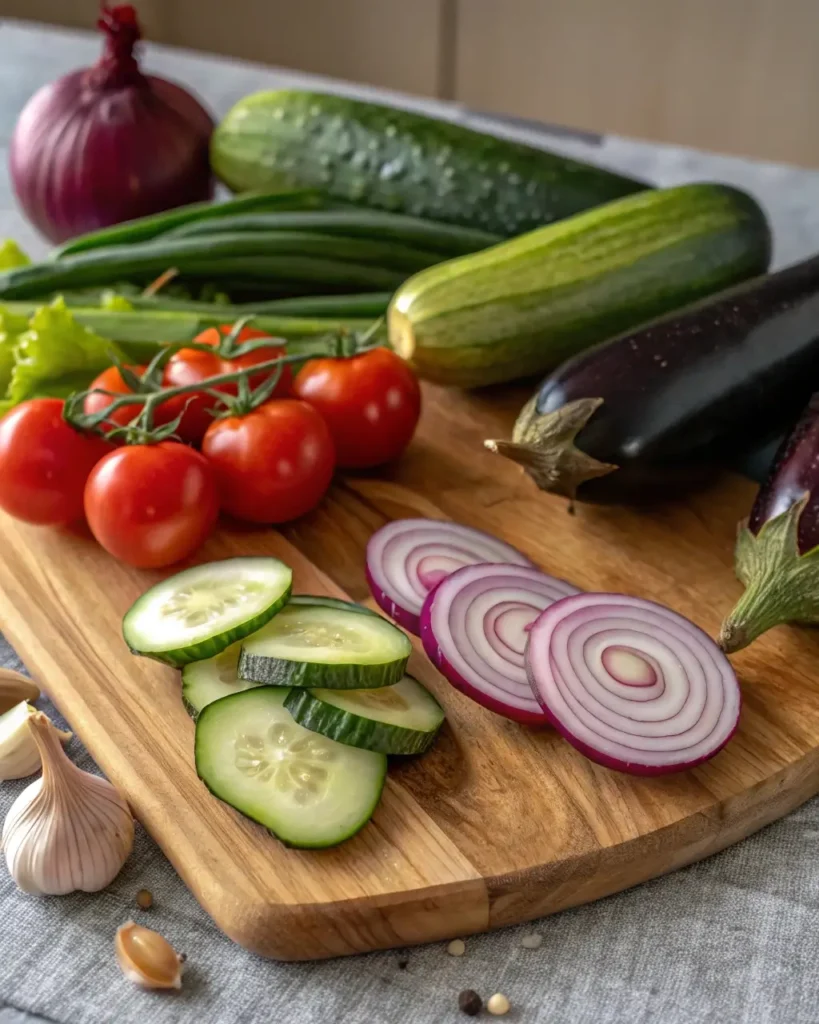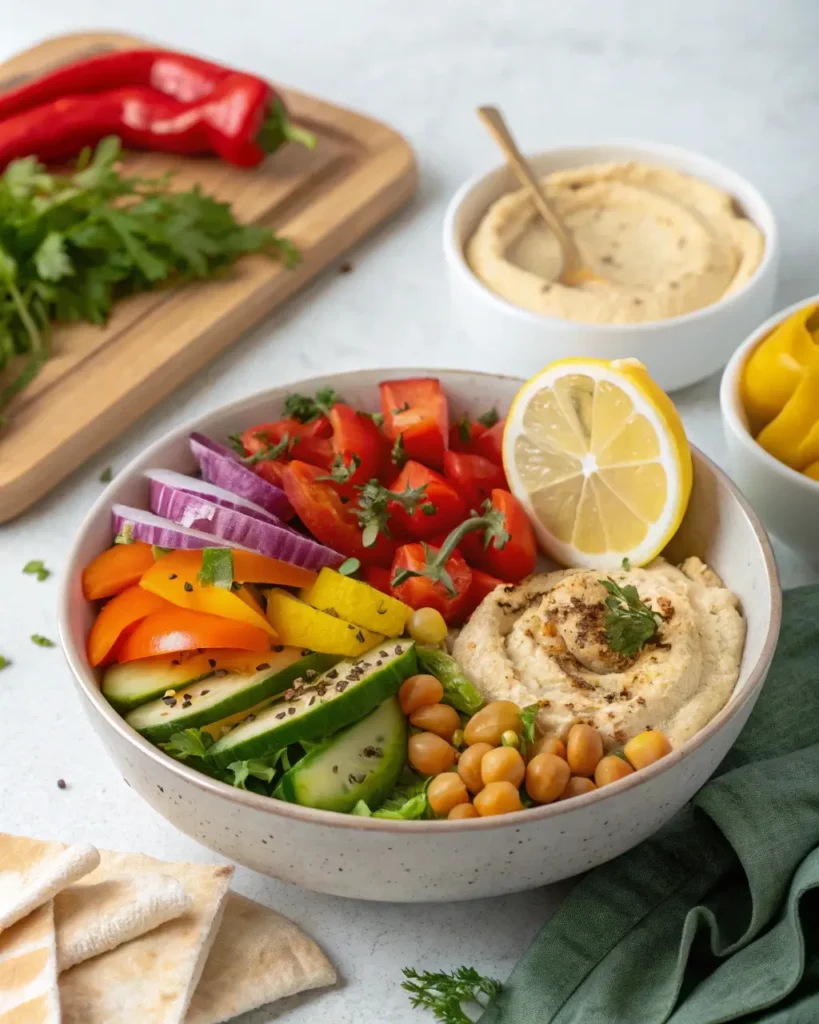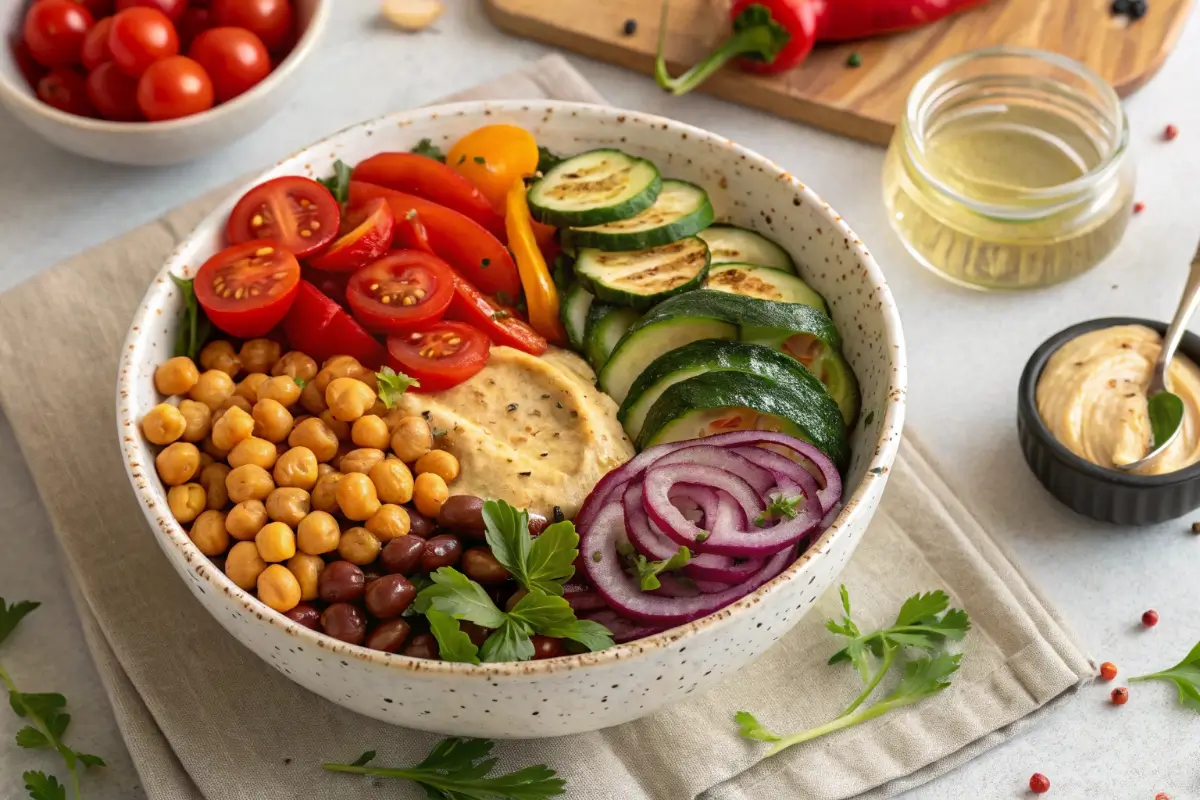Looking for a fresh, vibrant, and nourishing meal that checks all the boxes for taste, nutrition, and visual appeal? Mediterranean veggie bowls are a must-try solution that combines the heart-healthy ingredients of the Mediterranean diet with the convenience of bowl-style meals. Whether you’re meal prepping for the week, whipping up a quick lunch, or entertaining guests with clean-eating options, these bowls pack flavor, fiber, and healthy fats in every bite.
Mediterranean veggie bowls bring together colorful vegetables, creamy hummus, tangy olives, and zesty dressings—all in a bowl that’s easy to prepare and endlessly customizable. You can enjoy them warm or cold, loaded with grains, or fully plant-based. They’re also perfect for weeknight dinners, office lunches, and even picnic baskets.
Want more Mediterranean inspiration? Check out our vibrant Mediterranean Salmon—a flavorful protein pairing perfect for these veggie-packed bowls.
Let’s dive into what makes these bowls so irresistible!
Jump to:
Why You’ll Love This Recipe
– Nutritional benefits of Mediterranean veggie bowls
One of the biggest reasons to fall in love with Mediterranean veggie bowls is their health profile. Rooted in the Mediterranean diet, these bowls highlight whole foods, plant-based proteins, heart-healthy fats, and seasonal vegetables. Think: crunchy cucumbers, juicy cherry tomatoes, roasted red peppers, protein-rich chickpeas, and antioxidant-loaded greens.
They’re naturally:
- High in fiber
- Packed with essential vitamins (like A, C, and K)
- Low in added sugars
- Free from processed junk
If you’re trying to eat cleaner without giving up taste, these bowls are for you.
– What makes this bowl uniquely Mediterranean
What separates Mediterranean veggie bowls from your standard salad bowl? It’s all in the ingredients. Mediterranean dishes often include bold flavors from olives, feta cheese, lemon, tahini, oregano, and olive oil. These traditional elements are what make the bowl burst with color and taste. Plus, the combination of roasted and raw vegetables gives the dish a satisfying texture contrast.
Common Mediterranean elements include:
- Hummus or tzatziki for creaminess
- Kalamata olives for tang and saltiness
- Quinoa, couscous, or farro for a grain base
- Roasted eggplant or zucchini for depth
- A drizzle of lemony olive oil dressing
You’re not just building a bowl; you’re crafting a Mediterranean experience in every forkful.
Preparation and Cooking Time
– Total time breakdown (prep, cook, assembly)
One of the best things about Mediterranean veggie bowls is how quickly they come together—even on your busiest days. Whether you’re prepping from scratch or using leftovers, the total time commitment is minimal while the payoff is major in flavor and nutrition.
Here’s a time breakdown you can count on:
| Task | Time |
|---|---|
| Chopping fresh veggies | 10–15 minutes |
| Roasting vegetables | 20–25 minutes |
| Cooking grains (quinoa, couscous) | 10–15 minutes |
| Assembling the bowl | 5–10 minutes |
Total Time: 30–40 minutes (or less if batch-prepped)
By prepping ingredients in batches on the weekend, you can reduce daily assembly time to under 10 minutes. That makes Mediterranean veggie bowls one of the fastest go-to meals for clean eating.
– Quick prep tips for busy cooks
Want to make these bowls a staple in your weekly meal prep? Here are a few shortcuts that save time without cutting flavor:
- Use pre-chopped or frozen veggies: Bags of frozen zucchini, bell peppers, and spinach work well.
- Roast in batches: Roast multiple trays of veggies at once and refrigerate them for up to 4 days.
- Choose quick-cooking grains: Couscous cooks in under 5 minutes. Instant farro and microwavable brown rice are also great options.
- Make a dressing ahead of time: A simple mix of olive oil, lemon juice, garlic, and oregano keeps in the fridge for up to a week.
By prepping smart, you’ll always have the essentials for Mediterranean veggie bowls ready at your fingertips.
Ingredients
– Core Mediterranean vegetables and toppings
The true heart of Mediterranean veggie bowls lies in their fresh, colorful ingredients. This dish is a celebration of vegetables commonly found in Mediterranean cuisine—think bold, vibrant, and full of nutrients. Below is a base list, but feel free to mix and match based on what’s in season or in your fridge.
Essential Mediterranean vegetables:
- Cherry tomatoes – Juicy and sweet
- Cucumber – Crisp and refreshing
- Red onion – Adds a sharp bite and color
- Zucchini – Grilled or roasted for depth
- Eggplant – A Mediterranean classic
- Kalamata olives – Salty, rich flavor
- Roasted red peppers – Smoky and slightly sweet
- Spinach or arugula – For a leafy base
- Purple cabbage – Adds crunch and vibrant color
Want to know what the purple vegetable is often seen in Mediterranean dishes? It’s usually red cabbage or eggplant—both offer texture and color contrast.

Toppings & flavor enhancers:
- Feta cheese or plant-based feta
- Fresh parsley or mint
- Pine nuts or sunflower seeds
- Lemon zest or sumac
- Olive oil drizzle
These ingredients don’t just make Mediterranean veggie bowls look stunning—they deliver authentic flavor with every bite.
– Dressings and protein pairings for added flavor
The right dressing can turn a good veggie bowl into an unforgettable one. Mediterranean cuisine relies on light but flavorful dressings that highlight the natural taste of the veggies.
Simple dressing ideas:
- Olive oil + lemon juice + garlic + oregano
- Tahini + lemon + water + cumin
- Greek yogurt + dill + lemon + garlic (Tzatziki-style)
Protein options (optional but tasty):
- Grilled chicken or turkey
- Falafel or baked chickpeas
- Hard-boiled eggs
- Hummus or white bean spread
- Grilled shrimp or salmon
Want more seafood ideas? Discover great flavor with our Salmon Bowl Recipe—an ideal pairing with your veggie base.
These additions will keep your Mediterranean veggie bowls balanced, filling, and packed with Mediterranean authenticity.
Step-by-Step Instructions
– How to prep and cook each veggie
Creating Mediterranean veggie bowls starts with prepping your vegetables for maximum flavor and texture. Here’s a step-by-step guide to bring the Mediterranean to your kitchen:
1. Wash and chop your veggies:
- Slice cucumbers and cherry tomatoes into bite-size pieces
- Cut red onions into thin slivers
- Dice or slice zucchini and eggplant evenly
- Shred purple cabbage finely for crunch
2. Roast heartier vegetables:
- Preheat your oven to 425°F
- Toss zucchini, eggplant, and red peppers with olive oil, sea salt, and black pepper
- Roast for 20–25 minutes, flipping once for even browning
- Optional: Add garlic cloves for roasted flavor
3. Prepare grain base (optional):
- Cook quinoa, couscous, or farro according to package directions
- Fluff with a fork and season lightly with lemon zest and herbs
4. Optional proteins:
- Bake chickpeas tossed in paprika, cumin, and olive oil for 20 mins until crispy
- Grill or sauté your protein of choice like tofu or chicken
Roasting boosts sweetness and creates the perfect warm element for your Mediterranean veggie bowls.
– Assembling the perfect Mediterranean veggie bowl
Now for the fun part—assembly!
Layer your bowl:
- Start with a leafy base (spinach, kale, or arugula)
- Add your grains (if using)
- Spoon in roasted and fresh veggies
- Add toppings (feta, olives, herbs)
- Drizzle with dressing of choice
- Finish with protein or hummus
Want a zesty Mediterranean twist? Don’t miss our Pineapple Cucumber Salad—great as a side or part of the bowl itself.
Pro tip: Keep the dressing on the side if meal prepping to prevent sogginess.
These steps ensure your Mediterranean veggie bowls are not only Instagram-worthy but also bursting with nutrition and flavor.

How to Serve
– Serving suggestions and presentation ideas
When it comes to Mediterranean veggie bowls, the presentation is almost as important as the taste. With all those colorful veggies, herbs, and dressings, you’ve got a built-in visual appeal that’s perfect for serving at gatherings, meal prepping, or treating yourself to a restaurant-quality meal at home.
Here are a few serving suggestions to elevate your experience:
- Single Bowl Setup: Use a wide, shallow bowl to lay out each component side by side for a clean, organized look.
- Mason Jar Prep: Layer your ingredients from heaviest (grains, roasted veggies) to lightest (greens, herbs, dressing on top) for a perfect grab-and-go lunch.
- Family-Style Platter: Present everything separately buffet-style and let everyone build their own Mediterranean veggie bowls.
Don’t miss our flavorful Sweet Chili Chicken Rice Bowls if you want to explore a warm fusion bowl idea next.
Color Tip: Use at least one green, one red/orange, and one purple veggie for a vibrant plate that’s as appealing as it is nutritious.
– Pairing with side dishes or proteins
If you’re serving Mediterranean veggie bowls as part of a larger meal, consider pairing them with light, complementary sides and proteins. These add-ons can turn your bowl into a full Mediterranean-inspired feast.
Delicious pairings include:
- Grilled pita bread or garlic naan
- A small bowl of tzatziki or baba ganoush
- Stuffed grape leaves (Dolmas)
- Roasted chickpeas or falafel
- Marinated tofu or grilled shrimp
Looking for something fresh to sip with it? Try a lemon-mint sparkling water or a light cucumber-lime mocktail.
You can also pair your bowl with more seafood ideas—like our fresh and bright Mediterranean Salmon—for an ultra-satisfying, protein-rich dinner.

Additional Tips
– Tips for keeping vegetables fresh and vibrant
When preparing Mediterranean veggie bowls, freshness is key to maximizing flavor, crunch, and nutrition. Whether you’re meal-prepping or serving on the spot, these tips will help you preserve that just-chopped texture and vibrant color.
Keep it crisp:
- Store chopped cucumbers and onions in airtight containers with a splash of lemon juice to retain their bite.
- Line containers with a paper towel to absorb excess moisture from veggies like spinach or arugula.
- Slice tomatoes right before serving to avoid sogginess.
Roasting advice:
- Roast vegetables at a high heat (425°F) and spread them out on the tray to avoid steaming.
- Let roasted veggies cool before storing them to prevent condensation.
Dressing separation hack:
- Always store your dressing separately to keep the veggies from getting soggy. Small jars or silicone dressing cups work perfectly for lunchboxes or meal prep.
By using these strategies, your Mediterranean veggie bowls will stay as tasty on day four as they were on day one.
– Making the recipe ahead or for meal prep
These bowls are meal-prep superstars! Perfect for busy weeks or packed lunches, Mediterranean veggie bowls can be prepped in advance and stored without sacrificing quality.
Here’s how to plan ahead like a pro:
- Cook grains and proteins in bulk on Sunday for the week ahead.
- Portion veggies into containers and layer sturdier ingredients (like cucumbers, carrots, chickpeas) on the bottom.
- Add greens and dressings right before eating to maintain texture.
- Store components in separate airtight containers for max flexibility and freshness.
Need a lighter side idea? Don’t miss our refreshing Pesto Langostino Zucchini Recipes—they pair beautifully with your veggie bowls.
Whether you’re prepping for the week or just tomorrow’s lunch, Mediterranean veggie bowls offer a reliable, nutrient-packed, and endlessly adaptable option.
Recipe Variation
– Greek-style veggie bowl twist
If you love bold, herbaceous flavors and salty accents, a Greek-style Mediterranean veggie bowl is a variation you need to try. This version highlights the iconic ingredients found in traditional Greek cuisine, all in one nourishing bowl.
What makes it Greek?
- Base: Romaine lettuce or a mix of greens and parsley
- Veggies: Diced cucumbers, cherry tomatoes, kalamata olives, red onion, and roasted red peppers
- Cheese: A generous handful of crumbled feta
- Grain: Orzo pasta or farro
- Protein: Grilled chicken souvlaki or baked falafel
- Dressing: Classic Greek vinaigrette (olive oil, red wine vinegar, oregano, garlic)
Add some warm pita wedges on the side, and you’ve got a hearty and authentic Mediterranean veggie bowl with a Greek flair.
Want something with a sweet-savory balance? Try pairing it with Apple and Honey Glazed Chicken Tenders for a delicious twist.
– Vegan and gluten-free versions
Mediterranean veggie bowls are naturally adaptable for almost any dietary preference, especially vegan and gluten-free diets. With a few smart swaps, you can create a satisfying, plant-powered bowl without sacrificing any flavor.
Vegan swaps:
- Replace feta cheese with vegan feta or marinated tofu cubes
- Use hummus or white bean puree as your creamy component
- Add roasted chickpeas or lentils for protein
Gluten-free swaps:
- Choose quinoa, rice, or certified gluten-free couscous
- Avoid wheat-based pita; try gluten-free flatbread or crackers instead
Looking for an indulgent but healthy pairing? Check out our Mini Peanut Butter Cup Cheesecakes—a great plant-based treat to finish your bowl-based meal on a high note.
These variations ensure your Mediterranean veggie bowls can be customized for any lifestyle—without losing the fresh, bold essence of Mediterranean cooking.
Freezing and Storage
– How to store leftovers properly
One of the best perks of preparing Mediterranean veggie bowls is how well they store for future meals. Whether you’re packing lunch for the week or saving leftovers from dinner, proper storage ensures everything stays fresh and flavorful.
Refrigeration tips:
- Store each component (grains, veggies, proteins, dressings) in separate airtight containers.
- Most roasted vegetables and grains will last 3 to 4 days in the fridge.
- Leafy greens should be stored dry and unseasoned to prevent wilting—add them fresh when ready to eat.
Quick tip: Avoid storing bowls fully dressed unless you plan to eat them within 24 hours.
Want to extend freshness with minimal effort? Learn more about batch meals like our Creamy Coffee Cheesecake—an ideal dessert that stores just as well!
– Best practices for freezing without losing flavor
While fresh is best for Mediterranean veggie bowls, some components are freezer-friendly if you’re prepping in bulk.
What you can freeze:
- Cooked grains like quinoa or brown rice (store flat in freezer bags)
- Roasted vegetables like zucchini, eggplant, or peppers
- Cooked plant-based proteins like falafel or baked chickpeas
What NOT to freeze:
- Fresh cucumbers, tomatoes, or leafy greens—they’ll turn soggy upon thawing
- Feta cheese (crumbles and loses texture)
Freezing tip: Let cooked items cool completely before sealing. Label each bag with the date and contents. Use within 1–2 months for best flavor and texture.
By separating ingredients and using freezer-safe practices, you can build Mediterranean veggie bowls in minutes from frozen components and still enjoy peak flavor.
Special Equipment
– Kitchen tools that make veggie bowl prep easier
You don’t need fancy gear to make Mediterranean veggie bowls, but having a few kitchen essentials can dramatically cut down your prep time and boost consistency. Whether you’re a seasoned cook or just starting out, these tools help streamline the process:
1. Chef’s Knife & Cutting Board
Sharp, quality knives make slicing through cucumbers, peppers, and eggplant a breeze. A sturdy board with a non-slip grip also helps keep your workflow smooth.
2. Vegetable Peeler
Handy for shaving carrots or zucchini into ribbons—great for texture variety in your bowls.
3. Sheet Pan
Roasting is a core step in crafting flavor-packed Mediterranean veggie bowls. A good nonstick or parchment-lined sheet pan will give you beautifully caramelized veggies.
4. Salad Spinner
Helps dry greens thoroughly after washing, so your base stays crisp and doesn’t dilute the dressing.
5. Storage Containers
For meal prep lovers, BPA-free, airtight containers in various sizes make it easy to portion out veggies, grains, and dressings.
Looking for more prep inspiration? Check out how we simplify kitchen life in our Homemade Caramel Apples post—perfect for those who love make-ahead meals with visual flair.
– Optional gadgets to elevate your cooking game
Want to take your Mediterranean veggie bowls to the next level? These optional tools are worth the investment if you prepare meals frequently:
- Mini food processor: Quickly blend hummus, tahini dressing, or herbed yogurt sauces.
- Air fryer: A great tool for roasting chickpeas or veggies with less oil.
- Spiralizer: Turn zucchinis into zoodles for a low-carb base twist.
- Digital scale: For precise measurements if you’re tracking macros or calories.
You don’t need all of these, but even one or two can elevate the prep process, make meals more enjoyable, and keep your bowls consistently delicious.
Frequently Asked Questions
What veggies are in a Mediterranean bowl?
A traditional Mediterranean veggie bowl typically includes a mix of fresh and roasted vegetables such as cherry tomatoes, cucumbers, red onion, eggplant, zucchini, roasted red peppers, spinach, and kalamata olives. You can also include purple cabbage, carrots, and arugula for extra color and crunch.
Are Mediterranean bowls healthy?
Absolutely! Mediterranean veggie bowls are loaded with whole foods—fiber-rich veggies, heart-healthy fats (like olive oil and avocado), and plant-based proteins (like chickpeas or lentils). They follow the principles of the Mediterranean diet, which is known to support heart health, reduce inflammation, and promote weight management.
What are the 5 components of a Buddha bowl?
While Buddha bowls aren’t exclusive to the Mediterranean diet, many Mediterranean veggie bowls follow a similar formula. The five key components are:
Whole grains (quinoa, farro, couscous)
Fresh or roasted vegetables
Protein (chickpeas, tofu, chicken)
Healthy fats (olives, avocado, tahini)
Flavorful dressing or sauce
Mediterranean veggie bowls simply apply this formula with Mediterranean ingredients.
What veggies go in a Greek bowl?
A Greek-style Mediterranean veggie bowl often includes cucumbers, cherry tomatoes, red onions, kalamata olives, and roasted red peppers. It’s usually topped with crumbled feta cheese, fresh herbs, and served with a lemon-oregano vinaigrette. The flavor profile is tangy, herby, and incredibly refreshing.
What is a list of Mediterranean vegetables?
Common vegetables in Mediterranean cuisine include:
Zucchini
Eggplant
Red bell peppers
Tomatoes
Cucumbers
Spinach
Arugula
Onions
Artichokes
Fennel
These veggies form the colorful, flavorful backbone of Mediterranean veggie bowls and many other regional dishes.
What is the purple vegetable in Mediterranean food?
The “purple” vegetable often seen in Mediterranean dishes is either eggplant or red cabbage. Eggplant is typically roasted or grilled and adds a soft, savory depth to your bowl, while cabbage offers crunch and color. Both work beautifully in Mediterranean veggie bowls.
Conclusion
If you’re looking for a healthy, flavorful, and endlessly customizable meal, Mediterranean veggie bowls are the perfect choice. With their bright colors, crisp textures, and heart-healthy ingredients, they make clean eating feel indulgent and satisfying.
These bowls aren’t just a meal—they’re a lifestyle. Whether you enjoy them warm or cold, plant-based or protein-packed, with grains or without, they adapt beautifully to your preferences and dietary needs. Plus, they’re ideal for weekly meal prep, quick lunches, or dinner with friends.
Feeling inspired to try more wholesome recipes? Don’t miss our bold and colorful Sweet Chili Chicken Rice Bowls for another crowd-pleasing meal idea!
Now that you know how to build, customize, and store Mediterranean veggie bowls, it’s time to grab your favorite ingredients and get creative. Happy cooking!
PrintMediterranean Veggie Bowls
Fresh, healthy, and packed with color and flavor, these Mediterranean Veggie Bowls are the perfect lunch or dinner idea. Loaded with roasted and raw vegetables, grains, and your choice of protein, they’re easy to customize and ideal for meal prep.
- Prep Time: 15 minutes
- Cook Time: 25 minutes
- Total Time: 40 minutes
- Yield: 2–4 servings
- Category: Main Course, Lunch, Meal Prep
- Method: Roasting, Assembling
- Cuisine: Mediterranean
- Diet: Vegetarian
Ingredients
- 1 cup cherry tomatoes, halved
- 1 cucumber, sliced
- ½ red onion, thinly sliced
- 1 zucchini, sliced
- 1 small eggplant, diced
- 1 cup spinach or arugula
- ½ cup roasted red peppers, sliced
- ¼ cup kalamata olives
- ½ cup cooked quinoa (or couscous, farro)
- ¼ cup crumbled feta (or plant-based feta)
- ¼ cup hummus (or tahini dressing)
- 2 tablespoons olive oil
- 1 tablespoon lemon juice
- Salt and black pepper to taste
- Optional: roasted chickpeas, grilled chicken, falafel
Instructions
- Preheat oven to 425°F (218°C).
- Toss zucchini, eggplant, and red peppers with 1 tbsp olive oil, salt, and pepper. Roast for 20–25 minutes until golden and tender.
- Cook quinoa or preferred grain according to package directions. Fluff and set aside.
- Wash and prep all fresh vegetables. Slice cucumber, tomatoes, and red onion.
- In a bowl or plate, layer spinach or arugula as the base.
- Add grains, then layer roasted and raw veggies evenly.
- Top with olives, crumbled feta, and a dollop of hummus.
- Drizzle remaining olive oil and lemon juice on top.
- Add protein of choice, if using. Serve immediately or pack for later.
Notes
- For meal prep, keep dressing and greens separate until ready to serve.
- Vegan: Skip feta or use a dairy-free alternative.
- Gluten-free: Use quinoa or certified GF grains instead of couscous.
- Add-ins like artichokes, roasted carrots, or sunflower seeds enhance texture and nutrition.


